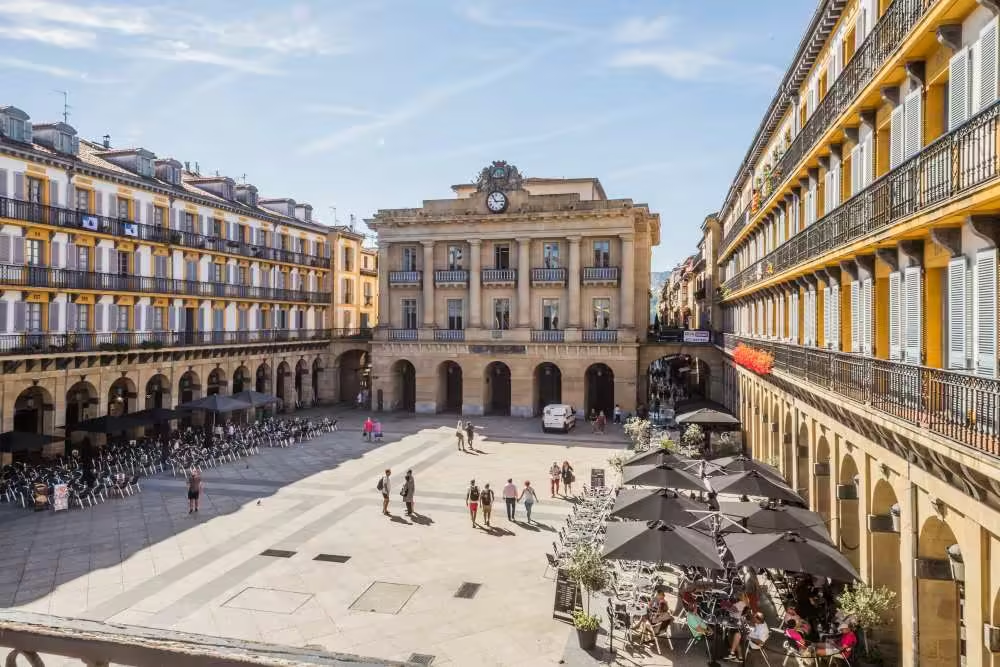The Constitution Plaza It is one of the architectural and historical jewels of Donostia-San Sebastián. Located in the Old Town, this arcaded plaza is a living testimony of the city’s rich history and culture. Inaugurated in 1722, the square has been a reference point for social and cultural activities. Throughout its existence, it has been known by various names, including Plaza Nueva and Plaza del 18 de Julio, reflecting the political changes and historical events that have marked the evolution of the city.

History and location
The square was originally designed by the architect Pedro de Ugartemendía and built on a space previously occupied by a plaza according to the project of Hércules Torrelli in 1723. This new design, in a neoclassical style, was necessary after the devastating fire of 1813 that devastated much of of the city during the siege of San Sebastián. The square follows the typical scheme of Castilian main squares, with a rectangular and symmetrical structure, surrounded by arcade buildings that create a welcoming and protected space. The dimensions of the plaza are perfectly modulated with 20 arches on the larger sides and 9 on the smaller sides, which gives it a characteristic visual harmony.
The balconies of the buildings surrounding the square are numbered, a curiosity that dates back to the time when the square was used as a bullring. The numbered balconies served as boxes from where spectators could enjoy the bullfights. Today, these numbers remain as a reminder of that bullfighting past, and the balconies continue to be a privileged observation point for the events that take place in the square.
Architecture and design
The architecture of the The Constitution Plaza reflects a sober and elegant neoclassical style, with influences from Castilian architecture. The buildings surrounding the square have a uniform façade, with windows and balconies that follow a regular pattern. This architectural uniformity is not only aesthetic, but also reinforces the sense of cohesion and order that characterizes traditional main squares. The arcades surrounding the square provide shade and shelter, creating a covered promenade that invites visitors to explore the shops, cafes and bars that animate this space.
The central building, which once housed San Sebastián City Hall until 1947, is an important focal point. After being used as a Municipal Library until 2000, it now houses offices of the City Council’s cultural area. This building stands out for its classical façade and its main balcony, which is often decorated with flags during official celebrations. The presence of this administrative building in the square underlines the importance of the The Constitution Plaza as the nerve center of the city’s public and cultural life.
San Sebastian Day Celebrations
The The Constitution Plaza is the epicenter of one of the most important festivities in the city: the Saint Sebastian’s Day, which is celebrated every January 20. This festival is known for drummed, a tradition that involves thousands of San Sebastian marching through the city dressed as cooks and soldiers, playing drums and barrels. The festival begins at midnight with the raising of the San Sebastián flag in the square, an exciting moment that marks the beginning of 24 hours of uninterrupted celebration.

The flag-raising ceremony is a solemn and emotional act that symbolizes the pride and identity of the inhabitants of San Sebastián. Throughout the day, different gastronomic societies and groups of drummers walk the streets, filling the city with the rhythmic sound of drums. The square becomes a meeting point for citizens who, armed with their drums and barrels, actively participate in this centuries-old tradition. The festival concludes with the lowering of the flag at midnight on January 21, an act that symbolizes the closing of the celebrations and leaves the city silent until next year.
Saint Thomas and the Sow Fair
Another significant event that takes place in the The Constitution Plaza is the Saint Thomas Fair, held on December 21. This fair is one of the most popular in San Sebastián and brings together thousands of people who come to enjoy local agricultural and artisan products. The square is filled with stalls where vendors offer a variety of products, from cheese and chistorra to sweets and cider. The fair is an opportunity for residents and visitors to try local cuisine and purchase fresh, quality products.
One of the most curious traditions of the Santo Tomás Fair is the presence of a live sow in the square. This sow, carefully cared for throughout the year, is brought to the fair as a symbol of rural life and ancient agricultural traditions. Visitors, especially children, enjoy seeing the animal, which becomes a central attraction of the fair. This tradition is reminiscent of livestock fairs that were common in the past and played an important role in the local economy and culture.



